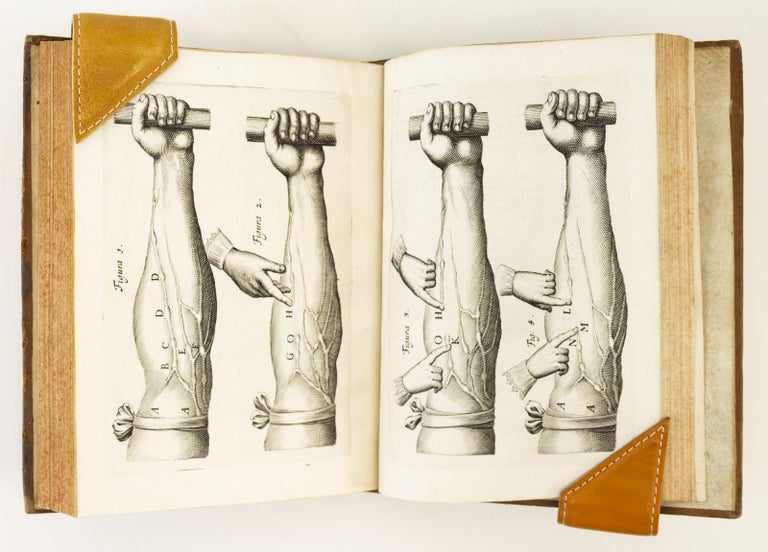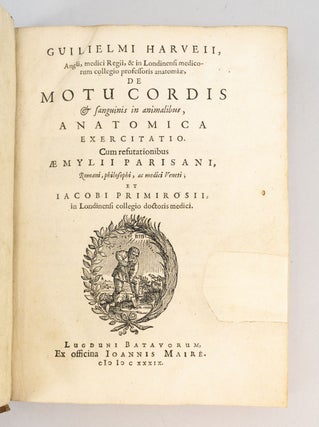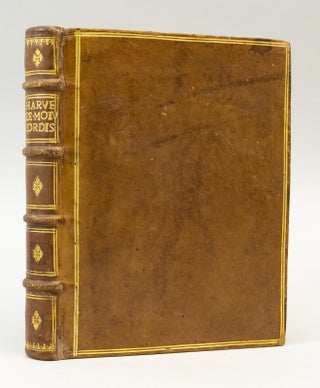DE MOTU CORDIS ET SANGUINIS IN ANIMALIBUS, ANATOMICA EXERCITATIO. CUM REFUTATIONIBUS AEMYLII PARISANI.
(Leyden: Johann Maire, 1639). 198 x 145 mm. (7 1/2 x 5 3/4"). 2 p.l., 84, [2] leaves, 267 pp. (bound out of order but complete). Third Edition.
VERY FINE CONTEMPORARY CALF, covers with double gilt fillet border, raised bands, spine compartments with floral lozenge at center (neat older repairs to joints). With two engraved plates showing veins in the arm. Two-inch repair to title page (not affecting text), perhaps to remove prior owner inscription. Keynes 3; Heirs of Hippocrates 417; Grolier Medicine 27 (1st ed.); NLM/Krivatsy 5329; Norman 1006 (1st ed.); Parkinson and Lumb 1147; PMM 127 (1st ed.); Waller 4089; Wellcome I, 3070. ◆A little spotting to boards, extremities a bit rubbed, two gatherings somewhat browned, occasional minor foxing, but AN OUTSTANDING CONTEMPORARY COPY, clean and fresh inside and out, THE PLATES ESPECIALLY BRIGHT, AND WITH RICH IMPRESSIONS.
This is a remarkably attractive copy of the third (but second complete) edition of one of the most important medical books ever published. Containing Harvey's discovery and experimental proof of the circulation of the blood, this work quickly became, in the words of Garrison-Morton, "the cornerstone of modern physiology and medicine." Heirs of Hippocrates explains that "what Vesalius was to anatomy, Harvey was to physiology; the whole scientific outlook on the human body was transformed, and behind almost every important medical advance in modern times lies the work of Harvey." The work was first published in Frankfurt in 1628, with a second edition including the "Exercitationes" of Parisanus appearing in Venice in 1635; the first is practically unobtainable, while the second lacked the plates, parts of the introduction, and chapters I and XVI. For our third edition, the publisher Maire restored these parts, included the illustrations, and also added the criticism and denials from the 1630 printing of the "Animadversiones" of Harvey's leading opponent, James Primerose (usually found at the end of the book, though here mistakenly bound at the beginning). Harvey had studied with Fabricius of Aquapendente, who published a monograph on the valves of the veins upon which Harvey improved and expanded. According to PMM, "It was left for Harvey to combine these discoveries, to conceive the idea of a circulation of the entire blood system, and demonstrate it conclusively by an exhaustive series of dissections and physiological experiments. For twenty years Harvey pursued his objective in both human and comparative anatomy. He proved experimentally that the blood's motion is continuous and always in one direction, and that its actual amount and velocity makes it a physical impossibility for it to do otherwise than return to the heart by the venous route, the heart being itself a muscle and acting as a pump. . . . He even suspected the existence of the capillaries connecting the smallest arteries with the smallest veins, but without the microscope he could not see them . . . . The arguments and demonstrations marshaled by Harvey were too cogent to admit of long resistance, and his work was accepted by medical men in his lifetime. Descartes used the discovery as a basis for his mechanistic physiology; English experimental scientists regarded the discovery as of equal importance with Copernican astronomy or Galilean physics; [and] Lower supplemented Harvey's work by discovering the role of the lungs in supplying the arterial blood with air." Not at all a common book to begin with, this famous edition is exceptionally difficult to obtain in a contemporary copy as well preserved as the present one. (ST14895)
Price: $45,000.00



